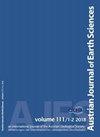About faunal life in Austrian aquifers - historical background and current developments
IF 1.1
4区 地球科学
Q2 Earth and Planetary Sciences
引用次数: 5
Abstract
In Austria all general types of aquifers (porous, karstic and fractured) are present and are subject of hydraulic and hydrochemical in- vestigations. However, in hydrogeological research it is a still widely neglected fact that groundwater flow is not only a flux of water, chemicals and heat within lithological units but that groundwater bodies may also act as habitats with very particular conditions for their inhabitants. In general groundwater inhabitants require three things: a place to live, oxygen and energy or food, respectively. Thus, the living conditions of groundwater animals are directly connected to hydrological and geomorphological conditions on a regional scale, and on a local scale, lithological and structural properties that control hydrogeological parameters such as porosity and hydraulic conductivity, recharge mechanisms and flow dynamics. In this paper we view Austrian hydrogeology from the perspective of groundwater fauna in order to elucidate the connection between the hydrogeological conditions and biological patterns. A brief review of groundwater biology research in general and spe- cifically in Austria, revealed that crustaceans are basically in the focus of groundwater research while other common groundwater dwellers, such as free-living nematodes, are less studied similarly. Porous aquifers are comparably well investigated by groundwater biologists, while fractured aquifers have rarely been considered as habitats to date. Due to the complex hydrogeological situation in Austria, with a greater portion of fractured and karstic aquifers, a systematic biological survey considering hydrogeological aspects may lead to a pronounced progress for the both disciplines, hydrogeology and groundwater biology. For hydrogeological purposes, the studies may provide the basis for using groundwater species (similar to the established method of using stable isotopes) as natural tracers in future studies. From the biological perspective, progress in the understanding of complex habitat-biota relations is expected to result from the investigation of hitherto unknown habitats. In addition, such a survey would not only be an important contribution to biodiversity and biogeography in Austria, it would also pro- mote groundwater research in a broader context, such as the need to protect groundwater as a valuable service providing system (e.g. water quality). Preliminary results from six test sites distributed to four different geological settings (Quaternary basin fill, Flysch-Zone, Northern Calcareous Alps and the Central Crystalline Zone within the Alps) show evidence for a link between the hydrogeological conditions and the present biological assemblages. However, a systematic survey is still required to understand which environmental factors mainly govern live in Austrian aquifers.关于奥地利含水层的动物生活-历史背景和当前的发展
在奥地利,所有一般类型的含水层(多孔的、岩溶的和裂缝的)都存在,都是水力和水化学研究的主题。然而,在水文地质研究中,一个仍然被广泛忽视的事实是,地下水流动不仅是岩性单元内的水、化学物质和热量的流动,而且地下水体也可以作为其居民具有非常特殊条件的栖息地。一般来说,地下水居民需要三样东西:居住的地方、氧气和能源或食物。因此,地下水动物的生存条件在区域尺度上与水文和地貌条件直接相关,在局部尺度上,控制孔隙度和导电性、补给机制和流动动力学等水文地质参数的岩性和构造性质直接相关。本文从地下水动物群的角度对奥地利水文地质进行了考察,以阐明水文地质条件与生物格局之间的联系。对奥地利地下水生物学研究的简要回顾表明,甲壳类动物基本上是地下水研究的重点,而其他常见的地下水居民,如自由生活的线虫,则很少得到类似的研究。地下水生物学家对多孔含水层进行了相当充分的研究,而迄今为止,裂隙含水层很少被认为是栖息地。由于奥地利的水文地质情况复杂,裂隙含水层和岩溶含水层的比例较大,考虑到水文地质方面的系统生物调查可能会导致水文地质学和地下水生物学这两个学科的显著进展。从水文地质的角度来看,这些研究可能为在未来的研究中使用地下水物种(类似于使用稳定同位素的既定方法)作为天然示踪剂提供基础。从生物学的角度来看,对迄今为止未知的生境的调查有望使对复杂生境-生物群关系的理解取得进展。此外,这种调查不仅将对奥地利的生物多样性和生物地理学作出重要贡献,而且还将在更广泛的范围内促进地下水研究,例如需要保护地下水作为一种宝贵的服务提供系统(例如水质)。分布在四种不同地质环境(第四纪盆地充填、弗莱施带、北阿尔卑斯钙质带和阿尔卑斯山脉中央结晶带)的六个试验点的初步结果表明,水文地质条件与当前生物组合之间存在联系。然而,仍然需要进行系统的调查,以了解哪些环境因素主要影响奥地利含水层的生活。
本文章由计算机程序翻译,如有差异,请以英文原文为准。
求助全文
约1分钟内获得全文
求助全文
来源期刊

Austrian Journal of Earth Sciences
Earth and Planetary Sciences-Paleontology
CiteScore
3.10
自引率
0.00%
发文量
0
审稿时长
>12 weeks
期刊介绍:
AUSTRIAN JOURNAL OF EARTH SCIENCES is the official journal of the Austrian Geological, Mineralogical and Palaeontological Societies, hosted by a country that is famous for its spectacular mountains that are the birthplace for many geological and mineralogical concepts in modern Earth science.
AUSTRIAN JOURNAL OF EARTH SCIENCE focuses on all aspects relevant to the geosciences of the Alps, Bohemian Massif and surrounding areas. Contributions on other regions are welcome if they embed their findings into a conceptual framework that relates the contribution to Alpine-type orogens and Alpine regions in general, and are thus relevant to an international audience. Contributions are subject to peer review and editorial control according to SCI guidelines to ensure that the required standard of scientific excellence is maintained.
 求助内容:
求助内容: 应助结果提醒方式:
应助结果提醒方式:


